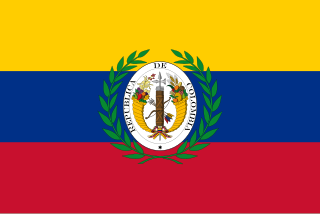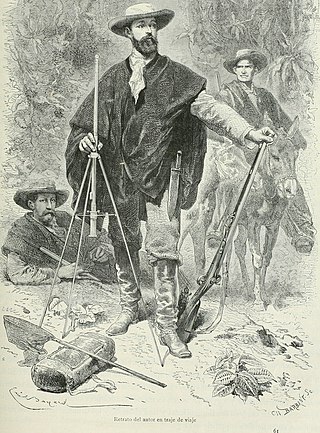
The Viceroyalty of the New Kingdom of Granada, also called Viceroyalty of New Granada or Viceroyalty of Santafé, was the name given on 27 May 1717 to the jurisdiction of the Spanish Empire in northern South America, corresponding to modern Colombia, Ecuador, Panama and Venezuela. Created in 1717 by King Felipe V, as part of a new territorial control policy, it was suspended in 1723 for financial problems and was restored in 1739 until the independence movement suspended it again in 1810. The territory corresponding to Panama was incorporated later in 1739, and the provinces of Venezuela were separated from the Viceroyalty and assigned to the Captaincy General of Venezuela in 1777. In addition to those core areas, the territory of the Viceroyalty of New Granada included Guyana, Trinidad and Tobago, southwestern Suriname, parts of northwestern Brazil, and northern Peru. A strip along the Atlantic Ocean in Mosquito Coast was added by the Royal Decree of 20 November 1803, but the British battled for administrative control.

The Adige is the second-longest river in Italy, after the Po. It rises near the Reschen Pass in the Vinschgau in the province of South Tyrol, near the Italian border with Austria and Switzerland, and flows 410 kilometres (250 mi) through most of northeastern Italy to the Adriatic Sea.

Cúcuta, officially San José de Cúcuta, is a Colombian municipality, capital of the department of Norte de Santander and nucleus of the Metropolitan Area of Cúcuta. The city is located in the homonymous valley, at the foot of the Eastern Ranges of the Colombian Andes, on the border with Venezuela. It comprises an area of approximately 1119 km2, with an urban area of 64 km2 and a rural area of 1055 km2. The city has a population of 777,106 inhabitants, which makes it the most populous municipality in the department and the sixth most populous municipality in the country. Similarly, its metropolitan area has an approximate population of 1,046,347.

The Venezuela national football team, nicknamed La Vinotinto, represents Venezuela in men's international football and is controlled by the Venezuelan Football Federation (FVF), the governing body for football in Venezuela. Their nickname is a reference to the unique “red wine” team color that is used on their home jerseys. When playing at home in official games, they usually rotate between three stadiums: The Polideportivo Cachamay in Puerto Ordaz, the Estadio José Antonio Anzoátegui in Puerto La Cruz and the Estadio Pueblo Nuevo in San Cristóbal. In friendly matches, they tend to rotate between the rest of the stadiums in the country.

The Gulf of Venezuela is a gulf of the Caribbean Sea bounded by the Venezuelan states of Zulia and Falcón and by La Guajira Department, Colombia. The western side is formed by the Guajira Peninsula. A 54 km (34 mi) strait connects it with Maracaibo Lake to the south.

Arepa is a type of flatbread made of ground maize dough stuffed with a filling, eaten in northern parts of South America since pre-Columbian times, and notable primarily in the cuisine of Colombia and Venezuela, but also present in Bolivia, Ecuador, and Central America.
GW Erco Shimano is a Colombian-registered UCI Continental cycling team that participates in road bicycle racing events on the UCI Continental Circuits. Prior to 2023, the team was based in Italy and held UCI ProTeam status. Gianni Savio manages the team, with assistance from directeurs sportifs Giovanni Ellena, Antonio Castano, Didier Paindaveine and Marco Bellini.

Gran Colombia, or Greater Colombia, officially the Republic of Colombia, was a state that encompassed much of northern South America and part of southern Central America from 1819 to 1831. It included present-day Colombia, mainland Ecuador, Panama, and Venezuela, along with parts of northern Peru, northwestern Brazil, and claimed the Essequibo region. The terms Gran Colombia and Greater Colombia are used historiographically to distinguish it from the current Republic of Colombia, which is also the official name of the former state.

Colombia–Venezuela relations refers to the diplomatic relations between the South American neighboring countries of Colombia and Venezuela. The relationship has developed since the early 16th century, when Spanish colonizers created the Province of Santa Marta and the Province of New Andalucia. The countries have a share history of achieving their independence under Simón Bolívar and becoming one nation—the Gran Colombia—which dissolved in the 19th century. Since then, the overall relationship between the two countries has oscillated between cooperation and bilateral struggle.

The following outline is provided as an overview of and topical guide to South America.

Thessia is a genus in the family Hesperiidae (Eudaminae).
The Sudamérica Rugby Women's Sevens, is the regional championship for women's international rugby sevens in South America. It has been contested since 2004. The tournament is held over two days, typically on a weekend. It is sanctioned and sponsored by Sudamérica Rugby.

Trachemys callirostris is a turtle in the family Emydidae found in Colombia and Venezuela.

Athesis is a Neotropical genus of clearwing (ithomiine) butterflies, named by Edward Doubleday in 1847. They are in the brush-footed butterfly family, Nymphalidae.

Athesis acrisione is a species of butterfly of the family Nymphalidae. It is found from Colombia and Ecuador.
The Achagua are an indigenous people of Colombia and Venezuela. At the time of the Spanish colonization of the Americas, their territory covered the present-day Venezuelan states of Bolívar, Guárico and Barinas. In the late twentieth century there were several hundred Achaguas remaining.

A ruana is a poncho-style outer garment native to the Colombian and Venezuelan Andes. In Colombia, the ruana is the characteristic and traditional garment of the department of Boyacá, initially made by indigenous and mestizo people, although it is also made in the departments of Cundinamarca, Antioquia, Nariño, Bogotá, Santander (Colombia), Norte de Santander and Caldas. In Venezuela it is widely used and made in the Andean states of Táchira, Mérida and Trujillo, used since the colonial times by all Venezuelan inhabitants, currently only in the Andean region its traditional use is maintained.

The Colombia–Venezuela border is an international border of 2219 kilometers (1378 mi) between Colombia and Venezuela, with a total of 603 milestones that demarcate the line. It is the longest border of both Colombia and Venezuela.

The 2015 Colombia–Venezuela migrant crisis refers to a diplomatic and humanitarian crisis that occurred in mid-2015 following the shooting of three Venezuelan soldiers on the Venezuela–Colombia border that left them injured and President of Venezuela Nicolás Maduro's response of deporting thousands of Colombians. Maduro's response of declaring a state of emergency, closing the border to Colombia indefinitely and deporting thousands of Colombians that lived near the border, struck fear in tens of thousands of other Colombians living in Venezuela resulting in their emigration from the country and a crisis involving separated families and Colombians seeking food and shelter. The actions of President Maduro were questioned by human rights groups, the United Nations, the European Union and the United States.















